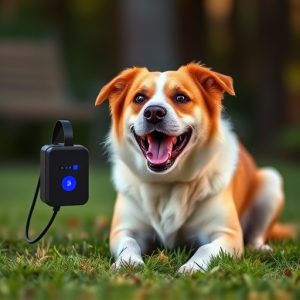Portable Dog Barking Prevention: A Comprehensive Installation Guide
Dog barking, driven by territorial, anxiety, loneliness, or attention triggers, can be managed with…….
Dog barking, driven by territorial, anxiety, loneliness, or attention triggers, can be managed with portable dog deterrent systems. These systems, outlined in a Portable Dog Deterrent Installation Guide, use sensors to detect barks and emit deterrents like ultrasonic sounds or water sprays. By strategically placing these devices in areas like backyards or porches, pet owners condition dogs to stop barking. The guide emphasizes choosing the right location, assembling the device, and adjusting sensitivity for effective, humane barking prevention.
“Tired of excessive dog barking that disrupts your peace? Discover the ultimate solution with our comprehensive guide to portable dog deterrent systems. We explore the science behind understanding canine behavior and how it triggers barking, offering a practical approach to addressing this common issue.
This article provides an in-depth look at these electronic devices, breaking down their components, functionality, and installation processes. By following our step-by-step Portable Dog Deterrent Installation Guide, you’ll be equipped to create a calmer environment for both you and your furry friend.”
- Understanding Dog Barking Patterns and Triggers
- Exploring Portable Dog Deterrent Systems: Components and Functionality
- Step-by-Step Guide to Installing a Portable Dog Barking Prevention System
Understanding Dog Barking Patterns and Triggers
Dog barking is a complex behavior that can stem from various triggers, and understanding these patterns is key to implementing an effective electronic system for prevention. Each dog has unique characteristics, but there are common reasons behind excessive barking, such as territorial instincts, anxiety, loneliness, or attention-seeking. Identifying specific triggers can help pet owners and professionals alike when choosing the right portable dog deterrent installation guide.
By recognizing patterns like when and why a dog barks, you can target specific scenarios. For instance, a dog might bark at strangers entering the property due to territorial behavior, requiring sensors or devices that detect movement and trigger a calming response. Alternatively, separation anxiety may lead to prolonged barking, necessitating a system that provides comfort or distraction during times of solitude. Understanding these patterns allows for personalized solutions, ensuring the effectiveness of electronic systems in controlling dog barking.
Exploring Portable Dog Deterrent Systems: Components and Functionality
Exploring portable dog deterrent systems offers a modern solution for managing canine behavior. These innovative devices are designed to address excessive barking, providing both peace of mind for homeowners and a more comfortable environment for the dog. A typical Portable Dog Deterrent Installation Guide would involve several key components: a control unit, a sensor, and a remote transmitter. The control unit acts as the brain of the system, triggered by the sensor when it detects bark frequencies. This activation can then emit various deterrents such as ultrasonic sounds or gentle sprays of water, depending on the specific design.
The functionality lies in its ability to condition dogs to associate barking with an unpleasant consequence, ultimately reducing unwanted behavior. These systems are often lightweight and portable, making them easy to install and adjust as needed. They can be strategically placed in areas where barking is a concern, ensuring both effectiveness and convenience for pet owners.
Step-by-Step Guide to Installing a Portable Dog Barking Prevention System
Setting up a portable dog barking prevention system is a straightforward process that involves just a few simple steps. First, locate an ideal spot for placement. This should be a place where your dog tends to bark excessively, like a backyard or porch. Ensure it’s within range of the system’s signal. Next, unbox your device and gather all necessary components, including the main unit, sensors, and batteries. Mount the sensors at eye level and roughly 1-2 feet apart to create an effective barrier around the area you want to protect.
Attach the main unit to a stable surface, keeping it within range of the sensors. Connect the power supply and ensure all components are properly wired. Test the system by triggering a sensor manually to confirm its sensitivity and range. Adjust settings as needed until it effectively discourages unwanted barking without causing harm or stress to your pet.
The implementation of a portable dog deterrent system offers a humane and effective solution for managing excessive barking. By understanding canine behavior and employing modern technology, pet owners can now actively address this common issue. Following the comprehensive steps outlined in this guide, including selecting the right components and installing the system correctly, you can help your furry friend learn appropriate behavior while ensuring peace and tranquility within your environment. Remember, with patience and persistence, a quiet and harmonious space for all is achievable.


